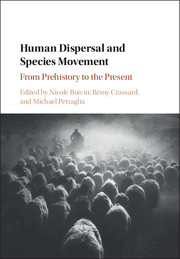Book contents
- Frontmatter
- Contents
- List of text boxes
- List of figures
- List of tables
- List of contributors
- Preface
- I Introduction
- II Origins: Species Movements in the Pleistocene
- III Across the water: Species movements by Coast and Sea
- IV Complexity: Species Movements in the Holocene
- 9 Dispersals, connectivity and indigeneity in Arabian prehistory
- 10 Reconstructing migration trajectories using ancient DNA
- 11 Out of the Fertile Crescent: The dispersal of domestic livestock through Europe and Africa
- 12 Adapting crops, landscapes, and food choices: Patterns in the dispersal of domesticated plants across Eurasia
- 13 Tracing the initial diffusion of maize in North America
- 14 Proto-globalisation and biotic exchange in the Old World
- V Invasion: The Movement of Invasive and Disease Species
- Index
- Plate section
- References
13 - Tracing the initial diffusion of maize in North America
from IV - Complexity: Species Movements in the Holocene
Published online by Cambridge University Press: 04 May 2017
- Frontmatter
- Contents
- List of text boxes
- List of figures
- List of tables
- List of contributors
- Preface
- I Introduction
- II Origins: Species Movements in the Pleistocene
- III Across the water: Species movements by Coast and Sea
- IV Complexity: Species Movements in the Holocene
- 9 Dispersals, connectivity and indigeneity in Arabian prehistory
- 10 Reconstructing migration trajectories using ancient DNA
- 11 Out of the Fertile Crescent: The dispersal of domestic livestock through Europe and Africa
- 12 Adapting crops, landscapes, and food choices: Patterns in the dispersal of domesticated plants across Eurasia
- 13 Tracing the initial diffusion of maize in North America
- 14 Proto-globalisation and biotic exchange in the Old World
- V Invasion: The Movement of Invasive and Disease Species
- Index
- Plate section
- References
Summary
Abstract
Domesticated from a wild teosinte grass in southern Mexico more than 6,000 years ago, maize (Zea mays ssp. mays L.) is today the world's single most important food crop. In this chapter I follow the initial diffusion of this major domesticate from its origin north through Mexico into the southwestern United States and then across the southern Plains into eastern North America, and consider its evolution under human selection during its long journey. Maize provides a well-documented example of a domesticate that was not part of a crop complex carried into new regions by expanding agricultural societies, but rather was exchanged, unaccompanied by other domesticates, from group to group.
Keywords: Maize, domestication, North America, crop diffusion
INTRODUCTION
Domesticated from a wild teosinte grass in southern Mexico more than 6,000 years ago, maize (Zea mays ssp. mays L.) is today the world's single most important food crop, with a recent annual harvest of more than 818 million metric tons (Varshney et al. 2012: Table 1). In this chapter I look at the early history of this major crop and follow its initial diffusion northward through Mexico into the southwestern United States and then across the Great Plains into the eastern woodlands of North America. A general temporal framework for the spread of maize throughout the Americas now exists, based on direct small-sample accelerator mass spectrometry (AMS) radiocarbon dating of cob and kernel remains recovered from sites scattered across this vast geographical area (Blake 2006). While this general spatial-temporal map of maize diffusion is still very much a work in progress (see ancientmaize.com), it does bring into clearer focus a wide range of questions, many of which are still unanswered, regarding the rates, routes, and mechanisms of initial human diffusion of the domesticate, its evolution under human selection, its adaptation to new environments, and the wide range of different ways in which it was added into and eventually came to dominate the subsistence economies of small-scale societies throughout North America.
SOUTHERN MEXICO: THE START OF THE JOURNEY
Populations of a wild teosinte grass that grow today along the central Balsas River valley in southern Mexico (Zea mays ssp. parviglumis Iltis and Doebley) have been identified as being phylogenetically most closely allied with maize, and are considered to be the present-day descendants of its probable wild progenitor (Matsuoka et al. 2002).
- Type
- Chapter
- Information
- Human Dispersal and Species MovementFrom Prehistory to the Present, pp. 332 - 348Publisher: Cambridge University PressPrint publication year: 2017
References
- 9
- Cited by

